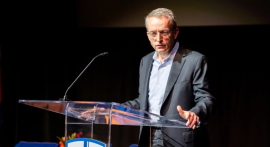
Nearly half of all Protestant pastors in the United States say the current economy is negatively affecting their churches, according to new data from Lifeway Research.
The latest tracking survey, conducted by phone from Sept. 2–24, 2025, included responses from 1,003 Protestant pastors across the country.
Overall, 49 percent of pastors reported that the economy is having a negative impact on their churches, while 41 percent said they are not feeling any economic effect. Another 9 percent indicated that current economic conditions are benefiting their congregations. These numbers are consistent with trends observed in 2022 and 2023.
This year’s findings show that African American pastors (63 percent) are the most likely to report economic hardship.
Regionally, pastors in the Northeast (58 percent) are more likely than those in the South (47 percent) to say the economy is harming their churches. Meanwhile, rural pastors (50 percent) are more likely than urban pastors (39 percent) to say they feel no economic impact at all.
Church size also appears to play a role. Pastors leading smaller congregations — those with fewer than 50 in attendance (55 percent) and those with 50–99 attendees (53 percent) — are more likely than those leading churches with 250 or more people (42 percent) to report that the economy is having a negative effect.
Mainline pastors are also feeling more pressure than their evangelical counterparts, with 55 percent saying the economy is hurting their congregations compared to 45 percent of evangelical pastors. Denominationally, Methodist (64 percent), Holiness (64 percent), and Presbyterian/Reformed (56 percent) pastors are more likely than Baptist (41 percent) and non-denominational (41 percent) pastors to say they are struggling financially.
On average, churches saw a 2.1 percent increase in offerings compared to 2024 — but with inflation rising 2.9 percent over the same period, overall giving power declined slightly.
More than one-third of churches (37 percent) reported higher giving levels than last year, while 39 percent said offerings have stayed the same and 20 percent saw declines.
Breaking down the numbers further, 20 percent of churches reported growth in giving of less than 10 percent, 14 percent saw increases of 10–24 percent, and 5 percent experienced jumps of 25 percent or more. Conversely, 5 percent said offerings fell by less than 10 percent, 10 percent saw declines of 10–24 percent, and 2 percent experienced drops of 25 percent or more.
African American pastors (33 percent) were more likely than white pastors (19 percent) to report that offerings are down compared to 2024.
Smaller congregations were also hit harder. Pastors of churches with fewer than 50 people (29 percent) and those with 50–99 attendees (23 percent) were more likely than those leading churches with 250 or more (12 percent) to report lower giving.
Meanwhile, pastors at the largest congregations (53 percent) were most likely to say their offerings have increased from last year.
Regionally, pastors in the Northeast (43 percent) and West (41 percent) were more likely than those in the Midwest (31 percent) to report growth in giving compared to 2024.
Among denominations, non-denominational (44 percent), Lutheran (39 percent), and Presbyterian/Reformed (39 percent) pastors were more likely than Methodists (27 percent) to see an increase in offerings.
“Pastors’ general impressions of the impact of the economy on their churches have noticeably improved since a year ago, but pastors are still five times more likely to be seeing negative effects as positive,” said Scott McConnell, executive director of Lifeway Research.
“The percentage of churches seeing growth in offerings matches the average of all the years surveyed, but it has been seven years (2017) since the percentage of churches with declining offerings was at 20 percent or less,” McConnell added. “One in five churches contracting financially is still a large number who are facing difficult financial decisions.”



















